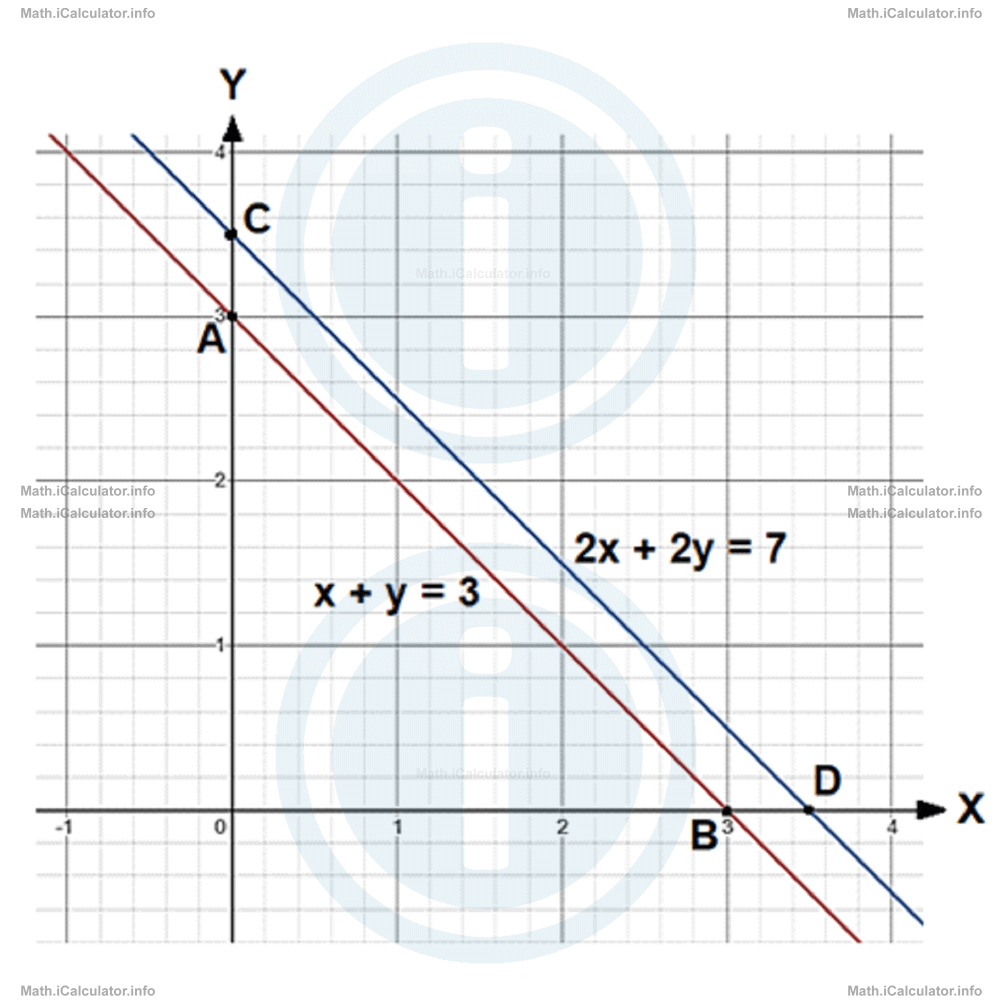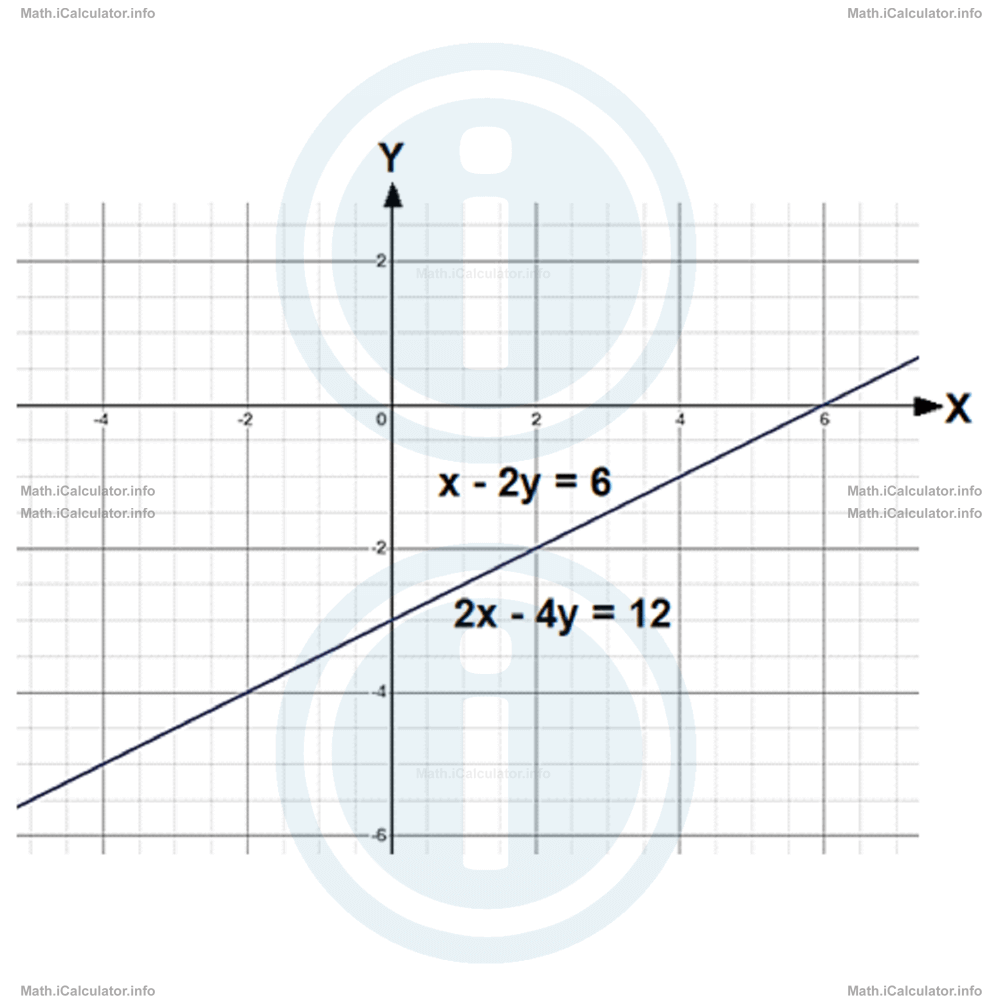Menu
Math Lesson 9.8.1 - Special Cases of Linear Equations
Please provide a rating, it takes seconds and helps us to keep this resource free for all to use
Welcome to our Math lesson on Special Cases of Linear Equations, this is the first lesson of our suite of math lessons covering the topic of Relationship between Equations in Linear Systems. Systems of Equations with One Linear and One Quadratic Equation, you can find links to the other lessons within this tutorial and access additional Math learning resources below this lesson.
Special Cases of Linear Equations
In the previous tutorial, we explained how to solve a system of linear equations. Recalling what we said in tutorial 9.7, it is clear that we can identify three methods for solving such systems:
- Elimination method, in which one of both equations is multiplied by suitable coefficients so that one of the variables can be eliminated after adding each other the equations of the new system obtained after such multiplication;
- Substitution method, in which we choose one equation to isolate a variable and substitute the equivalent expression in the other equation, to express it entirely in terms of the other variable; and
- Graphing method, in which we plot the graphs of both linear equations and see where they intercept, as the coordinates of that point represent the solution set of the system.
However, all examples discussed in tutorial 9.7 were carefully chosen to give a single pair of coordinates as a solution set. Such systems of linear equations that give a specific number pair as solutions are called independent systems of linear equations.
Moreover, all values found for the variables in the previous tutorial were integers. It is clear that such examples represent only a small portion of all possible systems containing linear equations. In the next paragraph, we are going to explore some special types of linear equations that require attention.
1. Linear equations with no solution
Let's take a look again at the first system of linear equations provided in the Introduction section of this tutorial.
If we use the elimination method to solve it, then the first equation must be multiplied by - 2. This yields
Adding both equations yields
This new equation has no solution, as no number multiplied by zero gives a non - zero number. Therefore, the original system of equations has no solutions.
If we try the substitution method instead (for example express y in terms of x in the first equation and substitute it in the second equation), this yields
and
2x + 6 - 2x = 7
0x = 7 - 6
0x = 1
This too, is an equation with no solution, as no number can multiply by zero and give 1.
Last, let's try to solve this system graphically. Thus, for the first equation, we take x = 0 and x = 3. The corresponding y-values are y = 3 and y = 0. Therefore, the points A(0, 3) and B(3, 0) belong to the graph of the first equation, so they are used to plot it.
On the other hand, if we take x = 0 and x = 3.5 in the second equation, the corresponding y-values are y = 3.5 and y = 0. Therefore, points C(0, 3.5) and B(3.5, 0) belong to the graph of the second equation, so they are used to plot it.
This is the figure obtained by plotting the two above graphs in the same coordinates system.

As you see, the two graphs are parallel. It is understandable as the system of equations had no solutions therefore the lines that represent each equation must have no common points.
In this way, we obtain an important conclusion about the systems of linear equations:
"If a system of linear equations has no solution, the graphs that represent each equation are parallel, i.e. they do not have any common point."
The systems of equations that have no solution are called inconsistent.
2. Linear equations with an infinity of solutions
Now, let's consider the other system of linear equations we gave in the Introduction section, i.e.
Let's try to solve it through the elimination method. Thus, multiplying the first equation by - 2, yields
Now, let's add the two equations to eliminate any variables. Thus,
Since this equation is true for any value of x and y, we say this system of linear equations has an infinite number of solutions; practically all numbers that give a true result for the first equation are solutions for the second equation as well. Therefore, since all solutions of the first equation are also true for the second one, it is obvious that we are dealing with equations that have the same graph. Such a system of equations is called dependent, as well as the equations contained in it.
The figure below shows the graph of the two linear equations of the last system.

Example 1
Determine whether the following systems of linear equations are independent, inconsistent or dependent.
- 3x - y = 2 - 6x + 2y = 7
- - x + 5y = 42x - 10y = - 8
- x + y = 92x - y = 12
Solution 1
- Let's use the elimination method to solve this system. Multiplying the first equation by 2 yields 3x - y = 2 - 6x + 2y = 7Adding both equations to each other yields
6x - 2y = 4 - 6x + 2y = 70x + 0y = 11This is an inconsistent system of linear equations, as it has no solutions. This is because no numbers multiplied by zero can give 11. - Again, we can use the elimination method for convenience. Thus, multiplying the first equation by 2 yields - x + 5y = 42x - 10y = - 8Adding both equations to each other yields
- 2x + 10y = 82x - 10y = - 80x + 0y = 0This is an independent system of linear equations, as whatever value we insert for x and y, the result will always be zero. - Now, let's use the substitution method. We can write x + y = 92x - y = 12Thus,
y = 9 - x
2x - (9 - x) = 12
2x - 9 + x = 12
3x = 12 + 9
3x = 21
x = 7y = 9 - 7Therefore, this is a dependent system of linear equation, as it has only a number pair as solutions that correspond to the point (7, 2) in the graph.
y = 2
More Relationship between Equations in Linear Systems. Systems of Equations with One Linear and One Quadratic Equation Lessons and Learning Resources
Whats next?
Enjoy the "Special Cases of Linear Equations" math lesson? People who liked the "Relationship between Equations in Linear Systems. Systems of Equations with One Linear and One Quadratic Equation lesson found the following resources useful:
- Special Cases Feedback. Helps other - Leave a rating for this special cases (see below)
- Equations Math tutorial: Relationship between Equations in Linear Systems. Systems of Equations with One Linear and One Quadratic Equation. Read the Relationship between Equations in Linear Systems. Systems of Equations with One Linear and One Quadratic Equation math tutorial and build your math knowledge of Equations
- Equations Video tutorial: Relationship between Equations in Linear Systems. Systems of Equations with One Linear and One Quadratic Equation. Watch or listen to the Relationship between Equations in Linear Systems. Systems of Equations with One Linear and One Quadratic Equation video tutorial, a useful way to help you revise when travelling to and from school/college
- Equations Revision Notes: Relationship between Equations in Linear Systems. Systems of Equations with One Linear and One Quadratic Equation. Print the notes so you can revise the key points covered in the math tutorial for Relationship between Equations in Linear Systems. Systems of Equations with One Linear and One Quadratic Equation
- Equations Practice Questions: Relationship between Equations in Linear Systems. Systems of Equations with One Linear and One Quadratic Equation. Test and improve your knowledge of Relationship between Equations in Linear Systems. Systems of Equations with One Linear and One Quadratic Equation with example questins and answers
- Check your calculations for Equations questions with our excellent Equations calculators which contain full equations and calculations clearly displayed line by line. See the Equations Calculators by iCalculator™ below.
- Continuing learning equations - read our next math tutorial: Variables, Coefficients and Constants. First Order Equations with One Variable
Help others Learning Math just like you
Please provide a rating, it takes seconds and helps us to keep this resource free for all to use
We hope you found this Math tutorial "Relationship between Equations in Linear Systems. Systems of Equations with One Linear and One Quadratic Equation" useful. If you did it would be great if you could spare the time to rate this math tutorial (simply click on the number of stars that match your assessment of this math learning aide) and/or share on social media, this helps us identify popular tutorials and calculators and expand our free learning resources to support our users around the world have free access to expand their knowledge of math and other disciplines.
Equations Calculators by iCalculator™
- Completing The Square In Quadratics Calculator
- First Order Equations With One Variable Calculator
- First Order Equations With Two Variables Calculator
- Solving Quadratics Through The Quadratic Formula
- Solving Systems Of Linear Equations With The Substituting Method Calculator
- Solving Systems With One Linear And One Quadratic Equation Calculator